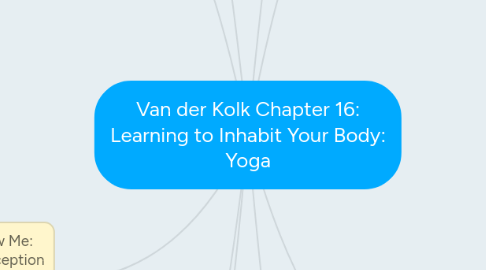
1. 4) Exploring Yoga
1.1. Yoga compared to DBT for PTSD
1.1.1. Volunteers had not responded to therapy
1.1.2. Yoga improved arousal levels
1.1.3. Yoga improved volunteers' relationship to their bodies
1.2. Yoga programs are effective for PTSD and include:
1.2.1. Breath practices
1.2.2. Stretches or postures
1.2.3. Meditation
1.3. Focus on the rhythm between tension & relaxation
1.4. HRV measured at end of session during shavasana
1.4.1. Trauma survivors have high levels of muscle activity relative to non-traumatized
1.4.2. Challenge for survivors is to attain complete relaxation and quiet surrender
2. 5) Learning Self-Regulation
2.1. Annie attends Yoga
2.2. Annie's responses
2.2.1. Terror from a corrective touch by an instructor
2.2.2. recognition of the healing value a of yoga
2.2.3. recognition of her disconnection from her body
2.2.4. Letting her body tell her the story it wants to
2.3. The "Happy Baby" pose is very challenging for traumatized as creates extreme panic
3. 6) Getting to Know Me: Cultivating Interoception
3.1. Sense of self is anchored in the body
3.1.1. We need to feel and interpret our inner sensations
3.1.2. numbing/sensation seeking prevents us from being fully alive
3.2. Alexithymia
3.2.1. result of numbing
3.2.2. can't anticipate or respond to the ordinary demands of their bodies
3.2.3. muffles the sensory delights of everyday experience
3.3. If you're not aware of what your body needs you can't take care of it
3.3.1. sensory awareness is a key to trauma recovery
3.3.2. traumatized people need to:
3.3.2.1. tolerate their sensations
3.3.2.2. befriend their inner experience
3.3.2.3. cultivate new action patterns
3.4. Benefits of yoga
3.4.1. notice the connection between emotions and the body
3.4.2. experiment with changing the way you feel
3.4.3. noticing what you feel creates emotional regulation
3.4.4. key phrases:
3.4.4.1. "notice that"
3.4.4.2. "what happens next"
3.4.5. body awareness changes the sense of time
3.4.5.1. sensastions rise and fall
3.4.5.2. not stuck in in a helpless state of horror
3.5. Regaining interoception can be potentially upsetting
3.5.1. newly accessed feelings can be too intense
3.5.2. postures involving the pelvis can trigger intense panic or flashbacks of assault
3.5.3. Key is to GO SLOW
4. 7) Yoga and the Neuroscience of Self-awareness
4.1. Meditation has a positive effect on self-regulation
4.2. yoga (20 weeks) increase activation of the "self system"
4.2.1. activation in insula
4.2.2. activation in medial prefrontal cortex
5. 8) Learning to Communicate
5.1. When people feel safe in their bodies they can translate formerly overwhelming feelings into language
5.2. Annie after 1 year of yoga
5.2.1. able to talk more freely about what happened to her
5.2.2. After a trigger she was able to contain herself
5.2.3. she was able to explain/verbalize the meaning of the trigger
5.2.4. Annie learned to "just have" her feelings without being "hijacked by them"
6. 1) The Legacy of Inescapable Shock
6.1. Annie's "smoke detector" (amygdala) alerts her survival brain
6.1.1. fight
6.1.2. flight
6.1.3. flee
6.2. Excitement about seeing someone triggers the terror of being molested
6.3. This response comes from children's ability to compartmentalize
6.3.1. love for her father vs. dread of assault are in separate states of consciousness
6.4. Annie felt she was at fault (limbic programming) vs. her rational thoughts
7. 2) The Numbing Within
7.1. Memory of helplessness stored as:
7.1.1. muscle tension
7.1.2. feelings of disintegration in affected body areas
7.2. Trauma survivors brace against and neutralize their unwanted sensations
7.2.1. Half turn to alcohol & drugs
7.2.2. Others turn to sensation seeking
7.2.2.1. cutting to stop numbness
7.2.2.2. high risk behaviours
7.3. Chronic anger & fear creates chronic muscle tension
7.3.1. Multiple sypmtoms
7.3.1.1. muscle spasms/back pain
7.3.1.2. migraines
7.3.1.3. chronic pain
7.3.1.4. fibromyalgia
7.3.2. Diagnoses seldom seen as their way to cope with their trauma symptoms
7.4. Annie's treatment involved helping her to:
7.4.1. regulate arousal
7.4.2. control her physiology
8. 3) Finding Our Way to Yoga: Bottom-Up Regulation
8.1. Heart Rate Variability (HRV) is a marker of Autonomic Nervous System functioning
8.1.1. Sympathetic N.S. - activation system
8.1.2. Parasympathetic N.S. - digestion, healing, sleep, relaxation
8.1.3. HRV = fluctuation in heart rate in response to breathing
8.2. Good ANS regulation:
8.2.1. can calmly assess a disruption
8.2.2. good arousal modulation: control over our impulses and emotions
8.3. Poor ANS regulation:
8.3.1. easily thrown off balance
8.3.1.1. physically
8.3.1.2. mentally
8.3.2. negative effect on thinking/feeling
8.3.3. negative impact on our body's stress response
8.3.4. increased venerability to heart disease, cancer, depression, & PTSD
8.4. PTSD survivors have poor HRV
8.5. Research Question: How can people improve HRV?
8.5.1. Led to study of Yoga
8.5.2. Breathing changes can improve anger/anxiety/depression
8.5.3. Yoga can improve:
8.5.3.1. Blood pressure
8.5.3.2. Elevated stress hormon secretion
8.5.3.3. Asthma
8.5.3.4. Lower back pain
8.6. Connection with David Emerson led to:
8.6.1. Publication of research on Yoga and PTSD
8.6.2. Development of Trauma Sensitive Yoga
8.7. Ways to improve HRV
8.7.1. Apps
8.7.2. martial arts
8.7.3. qigong
8.7.4. yoga
9. Case Study: Annie
9.1. Annie arrives terrified
9.2. Annie unable to deal with confrontation
9.2.1. makes her "mind disappear"
9.2.2. cutting/sef-destructive behaviour
9.3. years of theapy,medication, psychiatric hospitalization were unhelpful
9.4. Van der Kolk focuses on breathing and awareness
9.4.1. Focus on out breath (activates the parasympathetic nervous system)
9.4.2. Tapping of accupressure points
